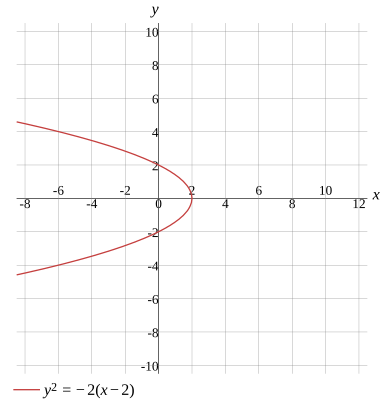Question
Identify the conic
Find the standard equation of the parabola
Find the vertex of the parabola
Find the focus of the parabola
Load more

y2=−2(x−2)
Evaluate
y2=4−2x
Use the commutative property to reorder the terms
y2=−2x+4
Solution
y2=−2(x−2)
Show Solution

Solve the equation
Solve for x
Solve for y
x=2−y2+4
Evaluate
y2=4−2x
Swap the sides of the equation
4−2x=y2
Move the constant to the right-hand side and change its sign
−2x=y2−4
Change the signs on both sides of the equation
2x=−y2+4
Divide both sides
22x=2−y2+4
Solution
x=2−y2+4
Show Solution

Testing for symmetry
Testing for symmetry about the origin
Testing for symmetry about the x-axis
Testing for symmetry about the y-axis
Not symmetry with respect to the origin
Evaluate
y2=4−2x
To test if the graph of y2=4−2x is symmetry with respect to the origin,substitute -x for x and -y for y
(−y)2=4−2(−x)
Evaluate
y2=4−2(−x)
Evaluate
More Steps


Evaluate
4−2(−x)
Multiply the numbers
4−(−2x)
Rewrite the expression
4+2x
y2=4+2x
Solution
Not symmetry with respect to the origin
Show Solution

Find the first derivative
Find the derivative with respect to x
Find the derivative with respect to y
dxdy=−y1
Calculate
y2=4−2x
Take the derivative of both sides
dxd(y2)=dxd(4−2x)
Calculate the derivative
More Steps


Evaluate
dxd(y2)
Use differentiation rules
dyd(y2)×dxdy
Use dxdxn=nxn−1 to find derivative
2ydxdy
2ydxdy=dxd(4−2x)
Calculate the derivative
More Steps


Evaluate
dxd(4−2x)
Use differentiation rules
dxd(4)+dxd(−2x)
Use dxd(c)=0 to find derivative
0+dxd(−2x)
Evaluate the derivative
More Steps


Evaluate
dxd(−2x)
Use differentiation rule dxd(cf(x))=c×dxd(f(x))
−2×dxd(x)
Use dxdxn=nxn−1 to find derivative
−2×1
Any expression multiplied by 1 remains the same
−2
0−2
Evaluate
−2
2ydxdy=−2
Divide both sides
2y2ydxdy=2y−2
Divide the numbers
dxdy=2y−2
Solution
More Steps


Evaluate
2y−2
Cancel out the common factor 2
y−1
Use b−a=−ba=−ba to rewrite the fraction
−y1
dxdy=−y1
Show Solution

Find the second derivative
Find the second derivative with respect to x
Find the second derivative with respect to y
dx2d2y=−y31
Calculate
y2=4−2x
Take the derivative of both sides
dxd(y2)=dxd(4−2x)
Calculate the derivative
More Steps


Evaluate
dxd(y2)
Use differentiation rules
dyd(y2)×dxdy
Use dxdxn=nxn−1 to find derivative
2ydxdy
2ydxdy=dxd(4−2x)
Calculate the derivative
More Steps


Evaluate
dxd(4−2x)
Use differentiation rules
dxd(4)+dxd(−2x)
Use dxd(c)=0 to find derivative
0+dxd(−2x)
Evaluate the derivative
More Steps


Evaluate
dxd(−2x)
Use differentiation rule dxd(cf(x))=c×dxd(f(x))
−2×dxd(x)
Use dxdxn=nxn−1 to find derivative
−2×1
Any expression multiplied by 1 remains the same
−2
0−2
Evaluate
−2
2ydxdy=−2
Divide both sides
2y2ydxdy=2y−2
Divide the numbers
dxdy=2y−2
Divide the numbers
More Steps


Evaluate
2y−2
Cancel out the common factor 2
y−1
Use b−a=−ba=−ba to rewrite the fraction
−y1
dxdy=−y1
Take the derivative of both sides
dxd(dxdy)=dxd(−y1)
Calculate the derivative
dx2d2y=dxd(−y1)
Use differentiation rules
dx2d2y=−dxd(y1)
Rewrite the expression in exponential form
dx2d2y=−dxd(y−1)
Calculate the derivative
More Steps


Evaluate
dxd(y−1)
Use differentiation rules
dyd(y−1)×dxdy
Use dxdxn=nxn−1 to find derivative
−y−2dxdy
dx2d2y=−(−y−2dxdy)
Rewrite the expression
dx2d2y=−(−y2dxdy)
Calculate
dx2d2y=y2dxdy
Use equation dxdy=−y1 to substitute
dx2d2y=y2−y1
Solution
More Steps


Calculate
y2−y1
Multiply by the reciprocal
−y1×y21
Multiply the terms
−y×y21
Multiply the terms
More Steps


Evaluate
y×y2
Use the product rule an×am=an+m to simplify the expression
y1+2
Add the numbers
y3
−y31
dx2d2y=−y31
Show Solution

Rewrite the equation
r=sin2(θ)−cos(θ)+1+3sin2(θ)r=−sin2(θ)cos(θ)+1+3sin2(θ)
Evaluate
y2=4−2x
Move the expression to the left side
y2+2x=4
To convert the equation to polar coordinates,substitute x for rcos(θ) and y for rsin(θ)
(sin(θ)×r)2+2cos(θ)×r=4
Factor the expression
sin2(θ)×r2+2cos(θ)×r=4
Subtract the terms
sin2(θ)×r2+2cos(θ)×r−4=4−4
Evaluate
sin2(θ)×r2+2cos(θ)×r−4=0
Solve using the quadratic formula
r=2sin2(θ)−2cos(θ)±(2cos(θ))2−4sin2(θ)(−4)
Simplify
r=2sin2(θ)−2cos(θ)±4+12sin2(θ)
Separate the equation into 2 possible cases
r=2sin2(θ)−2cos(θ)+4+12sin2(θ)r=2sin2(θ)−2cos(θ)−4+12sin2(θ)
Evaluate
More Steps


Evaluate
2sin2(θ)−2cos(θ)+4+12sin2(θ)
Simplify the root
More Steps


Evaluate
4+12sin2(θ)
Factor the expression
4(1+3sin2(θ))
Write the number in exponential form with the base of 2
22(1+3sin2(θ))
Calculate
21+3sin2(θ)
2sin2(θ)−2cos(θ)+21+3sin2(θ)
Factor
2sin2(θ)2(−cos(θ)+1+3sin2(θ))
Reduce the fraction
sin2(θ)−cos(θ)+1+3sin2(θ)
r=sin2(θ)−cos(θ)+1+3sin2(θ)r=2sin2(θ)−2cos(θ)−4+12sin2(θ)
Solution
More Steps


Evaluate
2sin2(θ)−2cos(θ)−4+12sin2(θ)
Simplify the root
More Steps


Evaluate
4+12sin2(θ)
Factor the expression
4(1+3sin2(θ))
Write the number in exponential form with the base of 2
22(1+3sin2(θ))
Calculate
21+3sin2(θ)
2sin2(θ)−2cos(θ)−21+3sin2(θ)
Use b−a=−ba=−ba to rewrite the fraction
−2sin2(θ)2cos(θ)+21+3sin2(θ)
Factor
−2sin2(θ)2(cos(θ)+1+3sin2(θ))
Reduce the fraction
−sin2(θ)cos(θ)+1+3sin2(θ)
r=sin2(θ)−cos(θ)+1+3sin2(θ)r=−sin2(θ)cos(θ)+1+3sin2(θ)
Show Solution

Graph
